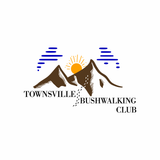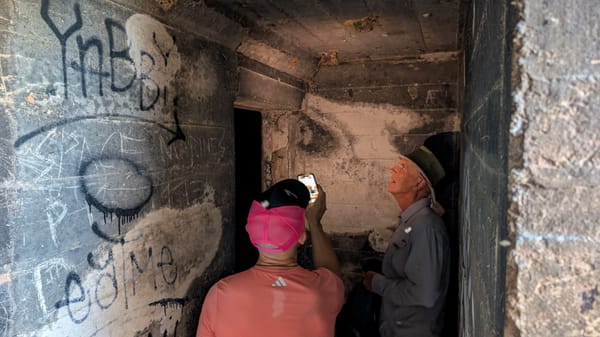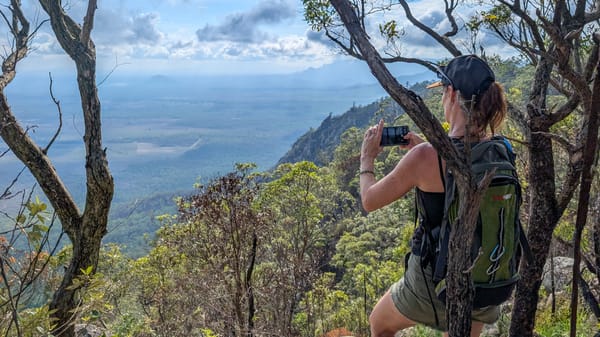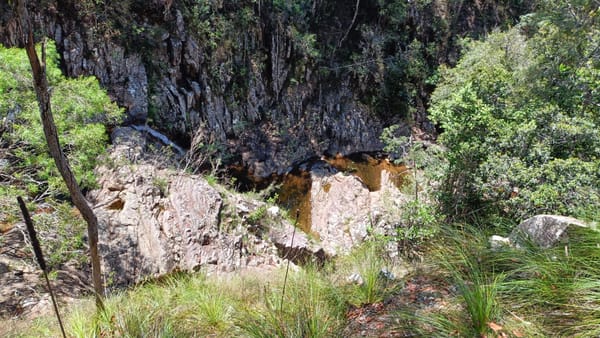Escape Magazine - April 1989
October 1988 Townsville Bushwalkers ESCAPE: new meeting venue, growing membership, farewell to Dave Whyte, trip reports from Mt Spec, Dalrymple Track and Waterview Creek, Chillagoe cave adventures, spider guide, and club history. A snapshot of North Queensland hiking and bushwalking life.
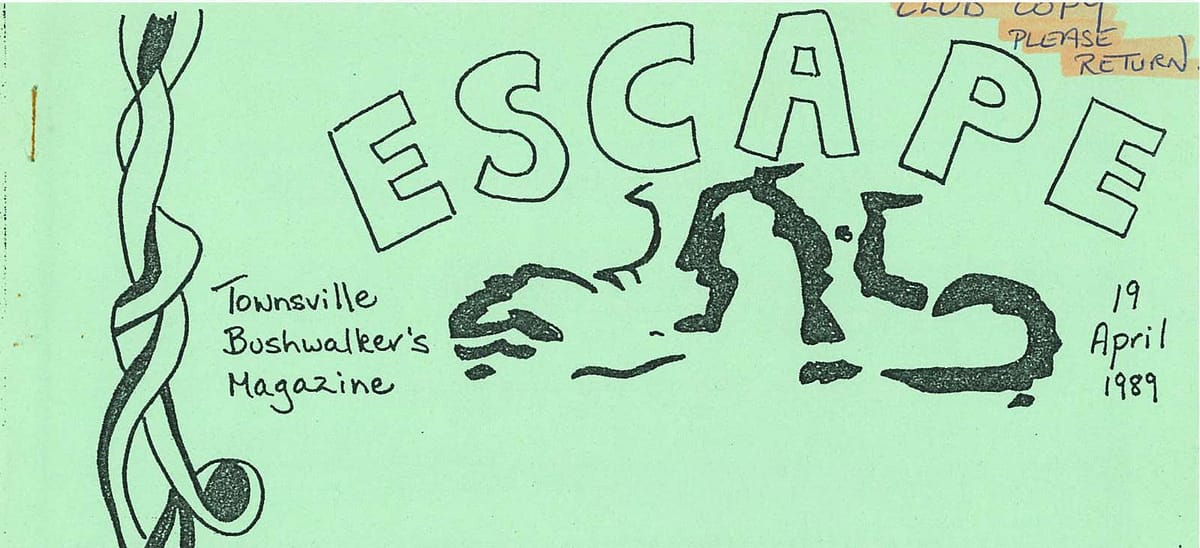
ESCAPE
Townsville Bushwalker's Magazine
19 April 1989
PRESIDENT'S REPORT
MARCH 1989
1988 is probably as memorable for the number of social gatherings as for the walks that the club undertook during the period. Nevertheless, my best recollections come from the walks in Bloodwood Creek (Herbert) and Hellhole Gorge. Thanks to Jim and Alan for steering us in the right directions.
The Dalrymple Track walk, held in conjuction with the Queensland Recreation Council was certainly a success if the number participating can be considered an indicator. Although the hoped for spin-off of new members did not eventuate, lessons learnt from the undertaking could be useful if we choose to repeat the exercise some time in the future.
Although we did have a number of good walks over the last twelve months, I feel that there are aspects of the club that can be improved.
Experience has shown that the method used to prepare last year's list of walks was not entirely satisfactory and a different approach adopted this year will, I hope, result in less change to the program.
The Club Log Book is still languishing, having received no entries for this period. Perhaps someone would like to take on the task of prodding people to contribute when new walks, or variations to old walks, are undertaken.
Membership continues to be our main concern. We need more members and new faces. The attendance at recent meetings gives cause for optimism, however, everyone should make the effort to make these new people feel welcome and help them enjoy their first walks.
The Club will be listed in the next edition of the Townsville telephone directory. This may also lead to new membership.
Looking forward to a year of good walks.
CHARLIE
TOWNSVILLE BUSHWALKING CLUB 1989 EXECUTIVE
| President | Charlie Allen |
| Vice President | Mark Jennings |
| Secretary | Alan Watson |
| Treasurer | Graham Ward |
| Magazine Editor | Mary Jane Henderson |
| Social Director | Peter Morgan |
For information regarding the Club, walks, etc. ring Graham or Marion on 71 6803.
THANK YOU
Thank you to everyone who contributed to this issue of "Escape". I hope for two more issues this year, one in August and another in November. Every/all/any contributions are gratefully accepted.
MARY JANE
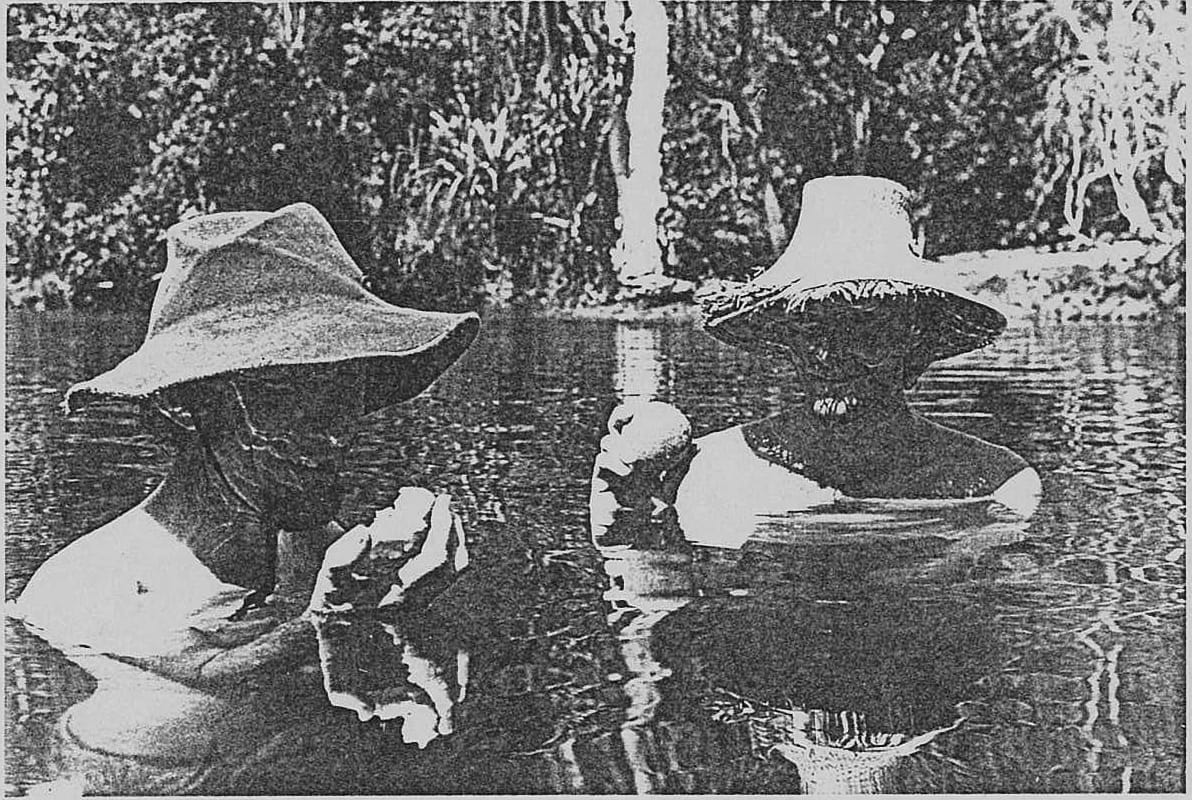
HINCHINBROOK ISLAND
Suzanne wrote the following article after her first-ever weekend walk. This was only Suzanne's second walk with the Club and considering the first one was Double Creek, I think she was remarkably brave to undertake the four day Easter extravaganza! Ed.
For the Easter weekend, I decided to go to Hinchinbrook Island and walk the new trail with the Townsville Bush-walkers. We started off from George Point; our destination for day one, Zoe Bay.
This was my first weekend walk ever and the heaviness of my pack astonished me. Taking too much food, and the wrong type was another mistake. We had a very hard, long walk to Zoe Bay. I found it exhausting but satisfying. I made it!
On Saturday we had a much more pleasant walk of a much shorter distance. Little Ramsay was a dream of a bay and spending Sunday just relaxing under trees speaking with bushwalkers was most enjoyable.
Monday was our last day and we headed for Blacksands Beach.
The bushwalking was really beautiful and the lovely fresh water in the falls was always most inviting. Sleeping out in our separate tents was also fun. Just the feel of being out under the sky surrounded by wildlife was interesting.
One thing I noticed was the friendliness of the people in the Bushwalking Club. This made the whole weekend so worthwhile. I recommend it for others in the future.
SUZANNE
"EN" TEAM REPORTING
Over the Easter weekend a rather large group of Townsville Bushies, along with a group of Cairns Bushwalkers and one Mackay ex-Townsville Bushie, set off over the newly marked Hinchinbrook track from George Point, on the southern tip, to Ramsay Bay. Because of the large number of people, we broke up into smaller groups, each with a leader. Glenn was our leader and as most of the group had the sound "en" in their name (eg. Glenn, Glynis, Glenda, Jenny, and Ben) we became The "En" Team. John, Roz, and Bob were the odd ones out. These are some of the comments from our group:
After crossing the first creek at Mulligan's Bay where the water was chest high (for me) Glenn said, "I'm glad you couldn't carry your pack over; I wanted to to back in the water. It was nice."
Ben told us, "I've learnt a lot on this trip, about how to pack properly and what food to take. Next time, the first thing I'll do is . . . put more in Jenny's pack." After that first day Ben was seen trying to give away some of his port to every passer-by. Ted kindly offered to take a water bottle-full off his hands and promptly gave it to Ann to carry!
Jenny said, "Next time I'll bring more food instead of other things." (No doubt "things" like Ben's two litres of port.)
Bob was observed sqeezing the last drops out of Ben's cask as he commented, "I don't drink much port." The same night he was also heard to say, "I don't eat chocolate . . . where's that chocolate?"
Ben again. "I kept losing my hat to that hold-on-a-minute plant. John who was behind me kept saying, "Here's your hat.""
John reported about his boots, "They're more waterproof than sandshoes, but when they get wet, they become buckets." After one creek crossing John removed his boots and as Glenn was drinking from the other side of the creek, one of the "buckets" came screaming past his head. John had hurtled one boot to safety and was swimming after the other one which hadn't quite made it.
Glenda was heard making comments about returning to certain spots on the island, but by boat!
Roz didn't spend much time with the group as she was trying to keep up with her tent which was in Gavin's pack.
After hearing how much further there was to go after a rigorous day one, Ben said, "Well there's only one thing left to do . . . Beam me up Scottie".
Charlie spent two nights with our group and when asked by one of his own group members as they passed by our campsite, where the rest of his group (Charlie's Pride) was, he answered, "I have a vague idea where everyone is."
Here's Ben again to wrap things up. "I like bushwalkers. They're really going places. The problem is, they walk to get there!"
GLYNIS
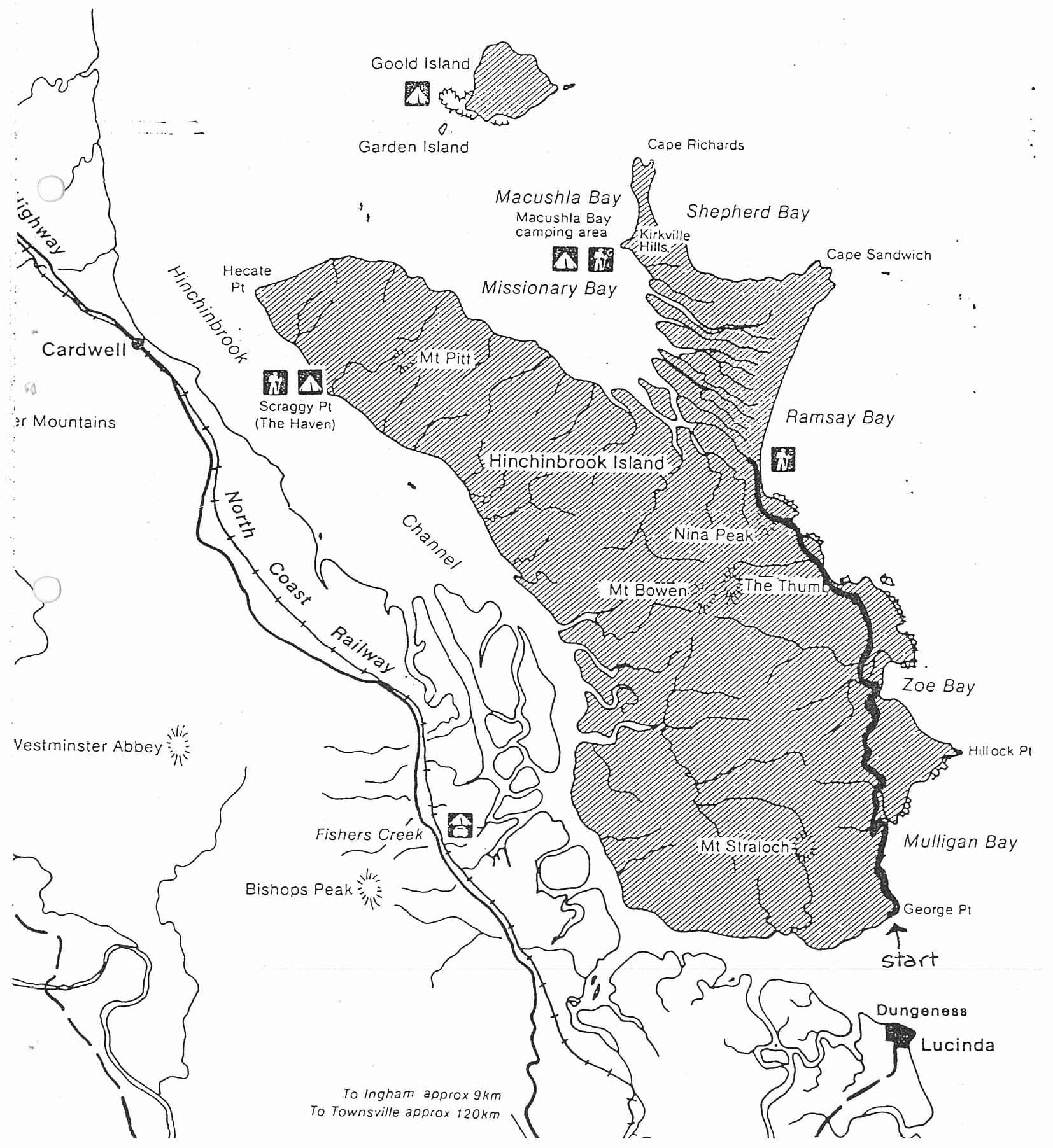
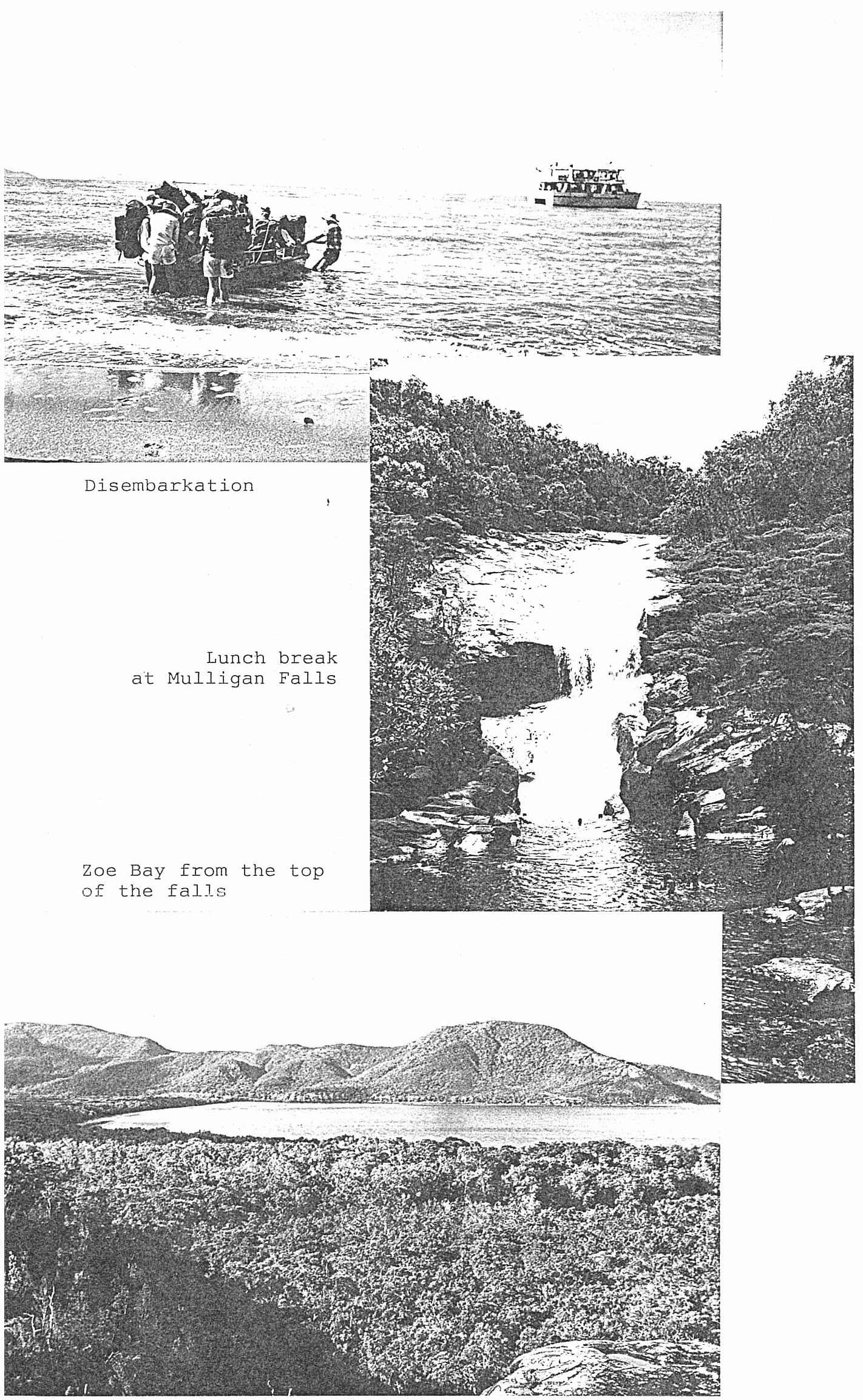
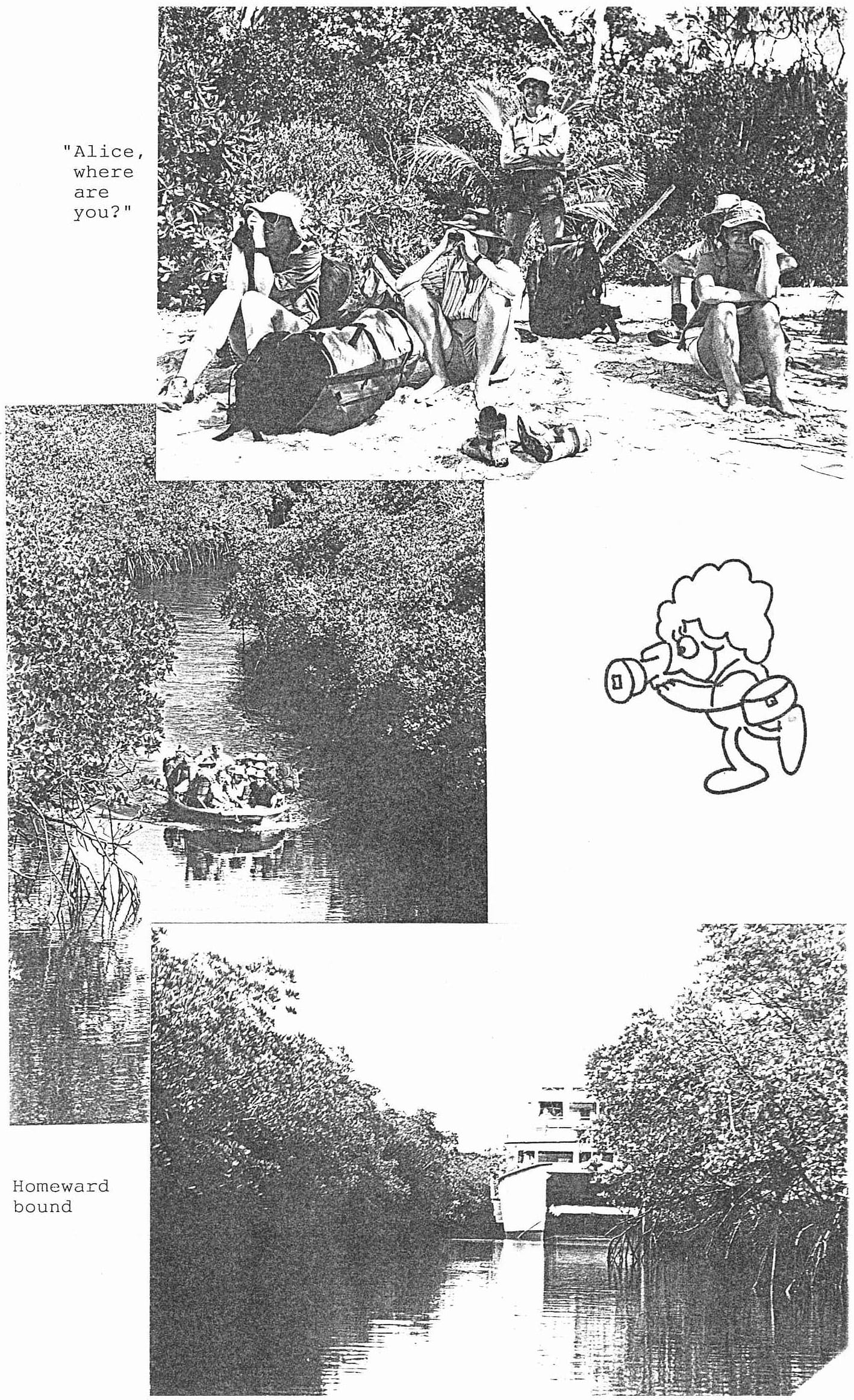
Left: Disembarkation, Lunch break at Mulligan Falls, Zoe Bay from the top of the falls; Right: "Alice,where are you?" Homeward bound;
SANDFLYOLOGY
Q. When is a sandfly not a sandfly?
A. When it bites you.
Most people call the tiny black "bities" common in mangroves, swamps, and beaches (particularly on Hinchinbrook Island), sandflies. These pests are almost certainly biting midges, not true sandflies which belong to the Phlebotomus group. Although bloodfeeders, Phlebotomus sandflies are not the pest in Australia that they are in other countries as they do not usually attack people. This is partly because they don't like the taste of us and partly because they are not common in populated areas. The biting sandflies common in the west after floods are actually blackflies. It is the larvae of these that crawl all over you after you've been down a rock-slide.
Biting midges are small, 1 - 3 mm long, so small that they can walk through fly screens three abreast. Like mosquitoes, it is only the female that requires a blood meal to provide protein etc. for egg production. Males and non-producing females feed on nectar instead.
Only a few species of midge bite people and those that do are opportunist feeders, biting any warm-blodded vertebrate they can. None feed on people exclusively. Pest species are found in three genera (groups): Styloconops, Lasiohelia and Culicoides.
Styloconops species breed in sand (hence the confusion with sand-flies) around the high tide mark. They are seldom found more than 50m from the breeding area and tend to swarm around your head when they attack.
Lasiohelia townsvillensisis a rainforest species that can be common in your garden where rainforest conditions are simulated. Like Styloconops, it does not travel far from its breeding area but will enter houses from the garden.
Most biting midges belong to the genus Culicoides. There are about 130 known species in Australia and probably just as many yet to be described. Many species, particularly those that are pests of stock, have been introduced from S.E. Asia by strong winds or brought in on ships.
There are about 16 species known to attack people and most of these breed in mud or in sand of the upper half of the inter-tidal zone. Some others breed like mosquitoes in water. A favourite spot is in tree holes, or in animal dung. One species even breeds in rotting prickly pear leaves. Larvae are small, active wrigglers that develop into inactive pupae within one to six weeks, depending on the species and temperature. Adults emerge within about two weeks.
Culicoides species bite a wide variety of hosts and a couple actually attack and draw blood from mosquitoes engorged with blood from a recent meal. Pest species usually bite around sunset and sunrise but will feed on calm, humid days and warm nights as well. They will attack at anytime in their breeding area as any campers at Zoe Bay will tell you. They tend to seek shelter in winds stronger than about 8 Km/h.
Pest range is the distance from a breeding area within which the species will cause regular infestation. The level of infestation ranges from light at the edge of the range, to extreme near the breeding area. Beyond this range, infestation is sporadic though it can be severe. People who are less used to midges seem to notice them more than those who live within the range and are used to them.
It is rare for an infestation to be due to one species alone although some species are commonly found attacking people. These include Culicoides subimmaculatus, C. molestus, and C. ornatus. Unfortunately, I didn't catch any midges on Hinchinbrook and don't know what sort they were. . . maybe next time.
Some species of Culicoides cause problems to stock in Australia and some overseas species transmit diseases to people. Australian species are not know to do so.
Mosquito coils and other repellants are quite effective against midges. Screens, unless specially made for midges, are useless. In fact, Culcicoides light traps use flyscreen mesh to keep larger insects out of the catch. Midges have a short proboscis and do not usually bit through clothes as mosquitoes do. Good air circulation and slow moving ceiling fans are good deter-rants as well.
Personal reactions to bites vary from slight redness to severe inflamation, especially if you scratch. If you react rapidly with small swellings, you are reasonably immune. If you take a while to react, hours or days, your immunity is poor and reaction more severe. I still see a few marks on people's legs three weeks after the Hinchinbrook trip. Anti-itch creams such as Bicozene of antihistamine creams are good. Some people have recommended Rexona ointment, ti-tree oil and even eating sulfur to avoid being bitten. Of course, the best idea is to avoid places where they are or to swat them before they bite. But then again, its hard to swat something you can't see.
GLENN
SUNRISE ON MOUNT COREE
I stepped onto the edge of a pillowy sea.
The moment was still as time travelled free.
Dropping the backpack, throwing the bush hat,
Clasping cold hands round shaky knees -
I sighed.
Deep in the valley beneath
An axe cracked like a shot
That echoed the violence and grief
Of a bushranger's lot.
I watched dragons' fires on the distant peaks,
Growing;
The bogone moths dancing wild electric leaps,
And the shrouded stone of Tibinbilla
Proud in the low mock sound.
The lyrics of a lyrebird
And rasping of kookaburras
Gave birth to a scud of songbirds,
Calling,
In the rustle of the trees.
I felt a cool thrill and shivered.
The last hush in the breeze.
Dawn's dark sentinels entreated
Moon and her attendants to flee.
For Mercury had entered with a flourish.
His message was clear to me.
M.J.S.
PUB NIGHT AT VIC PARK
A popular Club custom is our monthly Pub Night. Every Friday on the Friday before a one-day walk, hungry bush-walkers gather for a social meal at a local eating spot. In the recent past we have been seen dining at the Board-walk, however, a couple of weeks ago we ventured to a new venue, the Victoria Park Hotel in South Townsville.
I asked several diners how they enjoyed their meals.
Marion, Sherwyn, and Mike all had the Seafood Vol le Vent Special. For $3.50 there was plenty to eat - too much for Sherwyn. Some of the comments were, "looks good" ... "nice presentation" ... "the salad is nice" ... "the prawn (singular) was nice" ... "too salty" ... and finally, "it's okay for $3.50."
I noticed a lot of chips went uneaten. Graham who had Calamari and Chips said it was "okay" but that the oil being used for frying needed to be changed.
Both Barb and Charlie ordered the Fisherman's Basket (Hold the oysters.) At $6.50 Barb commented, "I wouldn't rush into it again" while Charlie agreed, "I'd choose another meal next time."
Several others also chose fish dishes. Glynis' Fish and Vegetables for $5.00 tasted alright. Jim described his Crumbed Fish and Salad as "Good value for $5.00 but it could have done with some tatar sauce." Mark had Sweet and Sour Fish for $5.00. He commented, "The sweet was missing. There was no pineapple in it, but apart from that it was quite nice."
Glenn appeared delighted with his $3.00 Steak Sandwich. It was "especially nice because it had no tomato in it."
Alan dined on Honyed Chicken for $6.00. It was "too salty but nice apart from that."
Carolyn's T-Bone and Vegetables for $6.00 was good value though Carolyn said she was "disappointed that the potato was mashed, not baked."
Paul was the only bushwalking diner who proclaimed his meal "delicious" and at $3.50 his Roast Chicken (with roasted potato and onion) looked to be the best meal that evening.
Bon Appetite.
MARY JANE
LITTLE CRYSTAL CREEK
9 April 1989
What started off as a nice easy walk soon turned into a not so easy walk.
As we pulled into the car park at the bridge the sound of rushing water told the dozen walkers there was more water coming down than normal.
On climbing down into the creek it soon became apparent that we would have to find an alternate route. It was decided to walk along the road for half a kilometre and drop down into the creek. This proved to be the right move as Ched, Doug, and Errol who managed to walk down the creek a short distance had to climb up to the road later anyway. They also walked back along the road before dropping down into the creek again.
It was ten o'clock before we found a pool that we could swim in. After a bite to eat it was off down the creek again.
We were continually climbing into and out of the creek because of the higher flow of water.
On looking for a pool to have lunch we caught up to the other three (Ched, Doug, and Errol) who were sunning themselves on a large outcrop of rock.
We walked on a bit further and found a great pool to stop at for a swim and some lunch.
After lunch we made our way down to the top pool where there is a magnificent gorge with the water dropping into the last and best pool in the creek. Everyone was quite impressed with this spot.
We made our way down to the bottom pool for a last swim before heading off down along the bank of the creek. It was much easier going here although the grass was high.
Back at the farm someone suggested the Frosty Mango where there were ice-creams, ice-cold mango juice, and coffee consumed rather quickly. There was one walker with a very healthy appetite who had a large bunch of grapes and three or four bananas to finish off his day!
I myself think Little Crystal Creek is one of the best day walks around Townsville.
MARK
